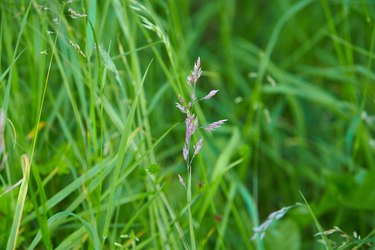
When selecting a turf for a new lawn, you may be considering a cool-season grass, like tall fescue (Festuca arundinacea or Lolium arundinaceum, USDA plant hardiness zones 3-6) or fine fescue (Festuca spp., zones 4-10). What is fine fescue grass? Fine fescue is a common term used to describe several species of fescue including creeping red fescue (Festuca rubra), chewings fescue (Festuca rubra ssp. commutata Gaudin), and hard fescue (Festuca ovina L.). There are several characteristics to consider that can help you decide which option is best for you.
Turf-Type Tall Fescue
Video of the Day
You can opt to plant tall fescue seed or a seed mixture that contains tall fescue. The grass has a coarse texture and a similar appearance to Kentucky bluegrass (Poa pratensis, zones 2-6) and perennial ryegrass (Lolium perenne, zones 5-7).
Video of the Day
It doesn't spread but instead grows in bunches or clumps. If you plant a mixture that contains tall fescue and don't mow regularly, you may see the clumps of tall fescue throughout your lawn. Due to this growth habit, you can expect to occasionally reseed bare patches to fill in the lawn.
Turf-Type Fine Fescue
Fine fescue varieties typically have a gray-green color and a fine leaf texture. When comparing chewing fescue vs. tall fescue, you will note that they are both bunch-type grasses that don't creep or spread. However, chewing fescue has a finer leaf texture and stiff, upright blades.
Creeping red fescue is similar to chewing fescue, but instead of a bunch-type growth habit, creeping red fescue spreads by rhizomes. Unlike fescues with a bunch-type growth habit, this fescue will grow and fill in bare spots in the lawn. Compared to other cool-season grasses, creeping red fescue grass blades tend to grow at a slower rate.
Hard fescue is lower-quality fescue for lawns compared to the other varieties because it does not grow as densely as the other fescues. However, its deep root system makes it a good option if you are concerned about erosion on part of your land. It has a bunch-type growth habit.
Tall vs. Fine Fescue
Tall fescue has a deep root system that helps to make the grass drought-tolerant. The grass also tolerates heat, and many cultivars are disease-resistant. It grows in full sun to part shade and should be mowed to a height of 2 to 3 inches. It is a good choice if you have children, pets or frequent gatherings since it has a medium to high tolerance for foot traffic.
Is fine fescue good for lawns? If the growth conditions in your yard support the grass, then it is an excellent option. Fine fescue grasses are also drought-tolerant, but they tend to be less tolerant of heat and cold when compared to tall fescue. These grasses only have a medium tolerance for foot traffic.
If you have a shady lawn, you may want to choose fine fescue over tall fescue since it does better with less sun. Fine fescues are less tolerant of full sun. The grass seeds also tend to grow faster, making them a popular choice for seeding your lawn. Mow fine fescue to a height of 1 1/2 to 2 1/2 inches.